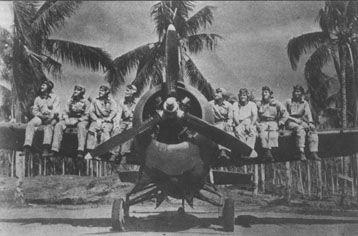Memorial Day 2015: Remembering WWII's U.S. Marine Corps Fighter Squadrons

When we think of the U.S. Marine Corps and World War II we all too often think of grand amphibious assaults at places like Tarawa or Iwo Jima. Rarely do we consider that the U.S. Marine Corps was, and is, more than a bunch of highly trained light infantry. So on this year's Memorial Day I would like to remind our readers of a few of the U.S. Marine Corps stunning Second World War aviation accomplishments. Please note that I am going to overlook for now Close Air Support (CAS), which was and is the bread and butter of Marine Corps aviation, and focus only on the Marine's Second World War record in air to air combat.
During World War II the U.S. Navy deployed 80 figher squadrons in combat zones. This will not surprise most readers as that is what we think of when we consider, if nothing else, the dozens of aircraft carriers included in the U.S. Navy's battle fleet. What may shock some of you however is that the U.S. Marine Corps deployed 50 fighter squadrons outside the United States during World War II (75 total with 23 for training purposes and two activated too late to see deployment), with these fighter squadrons playing a crucial role during the war against Japan.
The Marine Corps fighting squadrons racked up an impressive 2,627 confirmed aerial victories. Over one third of those victories (966) came from the 120 Marines who went on to become aces. This is consistent with other nation's experiences during the war, whereby relatively small numbers of highly skilled individuals had a disproportionate impact in the extroardinarily demanding and unforgiving combat environment of aerial warfare. What is unique about the U.S. Marine aces is that far fewer were shot down by their opponents. Only sixteen Marine aces died during the war (all causes). In the other U.S. sevice branches as many as a quarter of all aces lost their lives in amassing their records.
The top scoring Marine Corps fighter squadron was VMF-121. Established at Quantico in June of 1941 VMF-121 did the overwhelming majority of its damage from September 1942 to September 1943 mostly in the skies over or near Guadalcanal in the Soloman Islands (the picture with this post is of several VMF-121 pilots). The squadron was also deployed on Peleliu from September 1944 to September 1945, but by that point in the war had almost no opportunity to engage with the Japanese for the simple reason they had almost no aerial presence in VMF-121's area of operations. Flying the F4F-4 "Wildcat" (160 aerial victories) and then transitioning to the F4U-1 "Corsair" (45.5 aerial victories) in April 1943, the Marines of VMF-121 counted 205.5 aerial victories and produced 15 aces. VMF-121's top scoring ace was Medal of Honor winner Captain Joseph J. Foss with 26 kills.
Though VMF-121 flew from airfields, as did most Marine fighter squadrons, carrier based Marine Corps aviation racked up 221.5 confirmed kills. The leading Marine Corps carrier fighter squadron was VMF-221 amassing 66 kills flying from the Essex Class Carrier Bunker Hill (CV-17). VMF-221's leading pilot was Second Lieutenant Dean Caswell who compiled 7 kills, and was one of four Marine Corps pilots who became aces flying from Bunker Hill. The Bunker Hill is best remembered for being the carrier that took perhaps the greatest punishment of the war and yet still survived. On May 11, 1945 and while crusing off Okinawa Bunker Hill was hit by two bombs and two kamikaze's. The two kamikaze's flew into a fully fueled and armed flight deck. The massive explosions and fires resulting from these catastrophically bad circumstances caused 600 casualties (or nearly one quarter the ship's crew). The over 300 dead that day included 28 enlisted Marines and one Marine pilot. Thus, on today's Memorial Day my hope is that you remember not just those who gave so much on the ground and at sea, but also think of these otherwise often overlooked warriors of the sky.



Post new comment